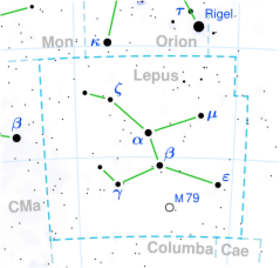Astronomy:AF Leporis
AF Leporis, also known as HD 35850, is an F-type main-sequence star located 87.5 light-years (26.8 parsecs) away from the Solar System in the constellation of Lepus. With an apparent magnitude of 6.3, it is near the limit of naked eye visibility under ideal conditions. While some studies consider it to be a close spectroscopic binary with a separation of 0.021 astronomical unit|AU,[8] other studies show no evidence of binarity, and it is likely that the supposed binarity is an artifact resulting from the presence of starspots.[9][4]
AF Leporis is a member of the Beta Pictoris moving group, with an astronomically young age of about 24 million years. It hosts a circumstellar disk and one known exoplanet.[7]
Planetary system

In 2023, a gas giant exoplanet was discovered in orbit around AF Leporis by direct imaging using the NIRC2 instrument at the W. M. Keck Observatory and the SPHERE instrument at the Very Large Telescope. It was also detected in astrometric data from the Hipparcos and Gaia spacecraft, allowing an accurate measurement of its mass.[7][4][13] Spectroscopic evidence suggests that AF Leporis b has a metal-rich atmosphere with silicate clouds.[6]
There have been multiple studies of AF Leporis b, which have found somewhat different parameters. Dynamical mass measurements range from the most recent value of 2.8 Jupiter mass[6] to 5.5 Jupiter mass.[4] Values for the planet's orbital inclination range from 50°+9°
−12°[7] to ~98°,[13] the former consistent with the stellar inclination of 54°+11°
−9° and suggesting an aligned system.[7] All studies have found that the planet has a fairly eccentric orbit.
| Companion (in order from star) |
Mass | Semimajor axis (AU) |
Orbital period (years) |
Eccentricity | Inclination | Radius |
|---|---|---|---|---|---|---|
| b | 2.8+0.6 −0.5 MJ |
8.2+1.3 −1.7 |
22.3+5.6 −6.7 |
0.4+0.3 −0.2 |
55+8 −13° |
1.2-1.55 RJ |
See also
References
- ↑ 1.0 1.1 1.2 1.3 1.4 1.5 Vallenari, A. et al. (2022). "Gaia Data Release 3. Summary of the content and survey properties". Astronomy & Astrophysics. doi:10.1051/0004-6361/202243940 Gaia DR3 record for this source at VizieR.
- ↑ 2.0 2.1 Samus, N. N. et al. (2009). "VizieR Online Data Catalog: General Catalogue of Variable Stars (Samus+ 2007-2013)". VizieR On-line Data Catalog: B/GCVS. Originally Published in: 2009yCat....102025S 1: B/gcvs. Bibcode: 2009yCat....102025S.
- ↑ Gray, R. O. et al. (July 2006). "Contributions to the Nearby Stars (NStars) Project: Spectroscopy of Stars Earlier than M0 within 40 pc-The Southern Sample". The Astronomical Journal 132 (1): 161–170. doi:10.1086/504637. Bibcode: 2006AJ....132..161G.
- ↑ 4.0 4.1 4.2 4.3 4.4 4.5 4.6 4.7 Mesa, D. et al. (February 2023). "AF Lep b: the lowest mass planet detected coupling astrometric and direct imaging data". Astronomy & Astrophysics 672: A93. doi:10.1051/0004-6361/202345865. Bibcode: 2023A&A...672A..93M.
- ↑ Anderson, E.; Francis, Ch. (2012). "XHIP: An extended hipparcos compilation". Astronomy Letters 38 (5): 331. doi:10.1134/S1063773712050015. Bibcode: 2012AstL...38..331A.
- ↑ 6.0 6.1 6.2 6.3 6.4 Zhang, Zhoujian et al. (September 2023). "ELemental abundances of Planets and brown dwarfs Imaged around Stars (ELPIS): I. Potential Metal Enrichment of the Exoplanet AF Lep b and a Novel Retrieval Approach for Cloudy Self-luminous Atmospheres". The Astronomical Journal 166 (5): 198. doi:10.3847/1538-3881/acf768. Bibcode: 2023AJ....166..198Z.
- ↑ 7.0 7.1 7.2 7.3 7.4 7.5 7.6 7.7 7.8 Franson, Kyle et al. (February 2023). "Astrometric Accelerations as Dynamical Beacons: A Giant Planet Imaged Inside the Debris Disk of the Young Star AF Lep". The Astrophysical Journal Letters 950 (2): L19. doi:10.3847/2041-8213/acd6f6. Bibcode: 2023ApJ...950L..19F.
- ↑ 8.0 8.1 Pawellek, Nicole et al. (April 2021). "A ~75 per cent occurrence rate of debris discs around F stars in the β Pic moving group". Monthly Notices of the Royal Astronomical Society 502 (4): 5390–5416. doi:10.1093/mnras/stab269. Bibcode: 2021MNRAS.502.5390P.
- ↑ 9.0 9.1 Järvinen, S. P. et al. (February 2015). "Doppler images and the underlying dynamo. The case of AF Leporis". Astronomy & Astrophysics 574: A25. doi:10.1051/0004-6361/201424229. Bibcode: 2015A&A...574A..25J.
- ↑ "V* AF Lep". SIMBAD. Centre de données astronomiques de Strasbourg. http://simbad.u-strasbg.fr/simbad/sim-basic?Ident=V%2A+AF+Lep.
- ↑ "MAST: Barbara A. Mikulski Archive for Space Telescopes". Space Telescope Science Institute. https://mast.stsci.edu/portal/Mashup/Clients/Mast/Portal.html.
- ↑ "Spotting a hidden exoplanet". ESO. 20 February 2023. https://www.eso.org/public/images/potw2308a/.
- ↑ 13.0 13.1 De Rosa, Robert J. et al. (February 2023). "Direct imaging discovery of a super-Jovian around the young Sun-like star AF Leporis". Astronomy & Astrophysics 672: A94. doi:10.1051/0004-6361/202345877. Bibcode: 2023A&A...672A..94D.
<ref> tag with name "Pearce2022" defined in <references> is not used in prior text.
 |



